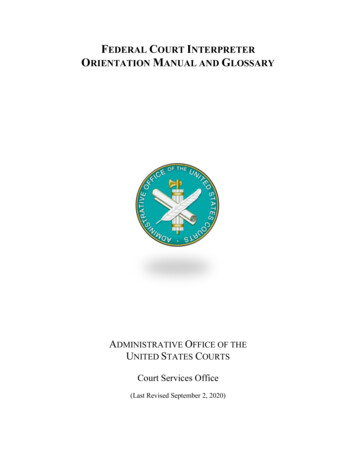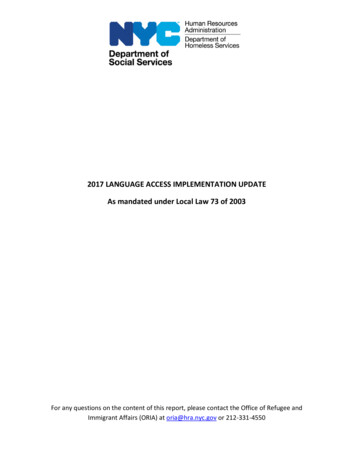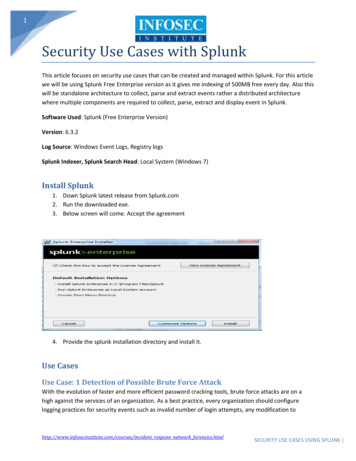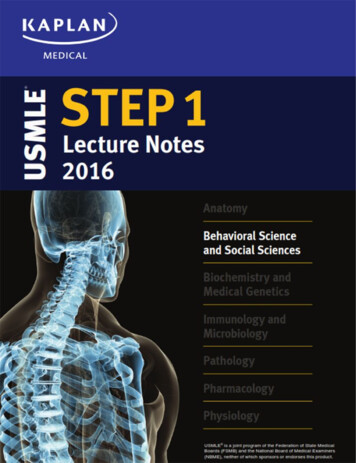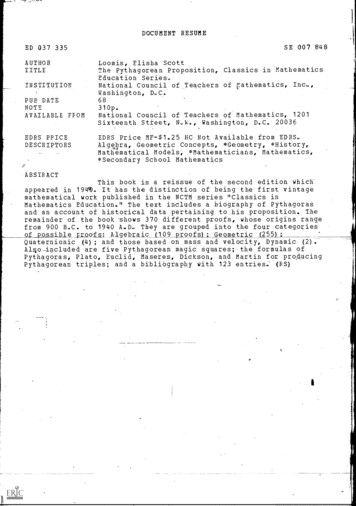
Transcription
Round Rock Research LLC v. ASUSTeK Computer Inc. et alDoc. 61IN THE UNITED STATES DISTRICT COURTFOR THE DISTRICT OF DELAWAREROUND ROCK RESEARCH LLC,rPlaintiff,fv.ICivil Action No. 11-978-RGAASUSTEK COMPUTER INC., et al.,IDefendants.Brian Farnan, Esq., Wilmington, Delaware; Paul Bondor, Esq. (argued), New York, NewYork; Attorneys for Plaintiff.IIrJohn Day, Esq., Wilmington, Delaware; James Pistorino, Esq. (argued), Palo Alto,California; Attorneys for Defendants.IIfMEMORANDUM OPINION!i'ifii!!'II,,Wilmington, Delaware2013AugustaD,-1-Dockets.Justia.com
The Defendants ASUSTeK Computer Inc. and ASUS Computer International, Inc.("ACI") filed a Motion to Dismiss [for lack of personal jurisdiction], or, in the Alternative, toTransfer [to the Northern District of California]. (D.I. 17). The motion was briefed (D.I. 18, 22,28) and argued. (D.I. 33). The Court granted jurisdictional discovery, and received furtherjursidictional briefing (D.I. 49, 54) and supplemental jurisdictional briefing. (D.I. 58, 59).ASUSTeK is a Taiwanese company. (D.I. 15,It has no physical presence in theUnited States. ACI is a California company, with a principal place of business in Fremont,California. (!d.It is a wholly-owned subsidiary of ASUSTeK. (!d.). ASUSTeK producesASUS brand computers and computer-related products. The Amended Complaint allegesgenerally that ASUS brand products infringe Plaintiffs ten asserted patents. The AmendedComplaint specifically names various ASUS products as infringing, to wit, the VW246H LCDmonitor, Eee Slate tablet computers, CM desktop computers, Eee "All-in-One" personalcomputers, Bamboo, U, UL, F, N, M, X, A, G, K, K52, UX, and B series notebook computers,Internet Radio series internet radios, Skype Phone AiGuru S2 internet phones, Essentio and Eeedesktop computers, T and R servers, and AMD and Intel series motherboards. (D.I. 15). Itappears that ASUSTeK sells these computer products to its Singapore subsidiary, ASUSTechnology Pte Ltd, which then sells computers to ACI (D.I. 51, Exh. 4, Depo. at 299), whichthen sells computers to retailers such as Best Buy and Office Depot, which, among other things,sell the computers in Delaware. ACI also sells its full line of products directly to Delawareconsumers. (!d. at 46). Over 6Y2 years, ACI's U.S. sales exceed 5,000,000,000. (!d. at 232).What are the procedural principles relevant to consideration of a motion to dismiss for-2-
lack of personal jurisdiction? The plaintiff bears the burden of showing personal jurisdiction."[I]n reviewing a motion to dismiss under Rule 12(b)(2), [the court] must accept all oftheplaintiffs allegations as true and construe disputed facts in favor of the plaintiff." Pinker v.Roche Holdings Ltd, 292 F.3d 361, 368 (3d Cir. 2002) (internal quotation omitted). "[O]nce thedefendant raises the question of personal jurisdiction, the plaintiff bears the burden to prove, by apreponderance of the evidence, facts sufficient to establish personal jurisdiction." Carteret Sav.Bank, FA v. Shushan, 954 F.2d 141, 146 (3d Cir. 1992). Thus, when the plaintiff has a plausiblejurisdictional theory, but insufficient evidence to prove the theory, the plaintiff should be grantedjurisdictional discovery.Although the plaintiff bears the burden of demonstrating facts that support personaljurisdiction, courts are to assist the plaintiff by allowing jurisdictional discovery unlessthe plaintiffs claim is "clearly frivolous." If a plaintiff presents factual allegations thatsuggest "with reasonable particularity" the possible existence of the requisite "contactsbetween [the party] and the forum state," the plaintiffs right to conduct jurisdictionaldiscovery should be sustained.Toys "R" Us, Inc. v. Step Two, S.A., 318 F.3d 446,456 (3d Cir. 2003) (citations omitted).What are the substantive principles relevant to the existence of personal jurisdiction? Inthis Court, a plaintiff has to show the existence of personal jurisdiction under Delaware law, andthat suchjurisdiction is not inconsistent with the Constitution's requirement of due process. Fora non-resident defendant, Delaware law is set forth in its long-arm statute. See 10 Del. C. §31 04.The due process analysis, in a patent case such as this, must follow decisions of the SupremeCourt and the Federal Circuit. See Beverly Hills Fan Co. v. Royal Sovereign Corp., 21 F.3d1558, 1564 (Fed. Cir. 1994).Interpretation of the Delaware long-arm statute has resulted in some decisions that offer-3-
conflicting principles. For example, analysis of the long-arm statute is a separate undertakingfrom analysis under the due process clause, and yet it appears that the results should be the same.Consider:Delaware courts apply a two-step analysis in determining the issue of personaljurisdiction over a nonresident. First, we must consider whether Delaware's long armstatute is applicable, recognizing that 10 Del. C. § 31 04(c) is to be broadly construed toconfer jurisdiction to the maximum extent possible under the Due Process Clause. Next,the court must determine whether subjecting the nonresident defendant to jurisdiction inDelaware violates the Due Process Clause ofthe Fourteenth Amendment.Hercules Inc. v. Leu Trust & Banking (Bahamas) Ltd, 611 A.2d 476,480-81 (Del. 1992)(citations omitted) (emphasis added). Further:The existence of personal jurisdiction depends upon two independent considerations-thelong arm statute and due process. Satisfying the first part of this analysis simply meansthat the legislative requirements of service of process have been met. It does not meanthat due process is satisfied, nor should it be confused with that concept. Step one isnothing more than an application of the language of the long arm statute while the secondstep involves issues of constitutional dimensions.iIId at 483 (citation omitted).In relevant part, the Delaware long arm statute provides:(c) As to a cause of action brought by any person arising from any of the acts enumeratedin this section, a court may exercise personal jurisdiction over any nonresident, or apersonal representative, who in person or through an agent:(1) Transacts any business or performs any character of work or service in theState;(2) Contracts to supply services or things in this State;(3) Causes tortious injury in the State by an act or omission in this State;(4) Causes tortious injury in the State or outside of the State by an act or omissionoutside the State if the person regularly does or solicits business, engages in anyother persistent course of conduct in the State or derives substantial revenue fromservices, or things used or consumed in the State; .-4-IIt!ilrill
10 Del. C. § 3104. The first three subsections provide for specific jurisdiction while the fourthprovides for general jurisdiction. See Boone v. Oy Partek AB, 724 A.2d 1150, 1155 (Del. Super.1997), aff'd, 707 A.2d 765 (Del. 1998).[D]ue process requires . that in order to subject a defendant to a judgment in personam,if he be not present within the territory ofthe forum, he have certain minimum contactswith it such that the maintenance of the suit does not offend "traditional notions of fairplay and substantial justice." . [T]he minimum contacts must be "purposeful" contacts.Beverly Hills Fan Co. v. Royal Sovereign Corp., 21 F.3d 1558, 1565 (Fed. Cir. 1994) (citationsomitted).[E]ven if the requisite minimum contacts have been found through an application of thestream of commerce theory or otherwise, if it would be unreasonable for the forum toassert jurisdiction under all the facts and circumstances, then due process requires thatjurisdiction be denied. . . . In general, these cases are limited to the rare situation inwhich the plaintiffs interest and the state's interest in adjudicating the dispute in theforum are so attenuated that they are clearly outweighed by the burden of subjecting thedefendant to litigation within the forum./d. at 1568 (footnote omitted).There are ten counts against ACI and ASUSTeK. It appears to me that ACI concedesspecific personal jurisdiction over it for the claims involving eight of the ten patents. (D.I. 54,pp. 5-7). The parties' arguments, as to ACI, concentrate on whether there is personal jurisdictionover the claims involving the' 109 and '531 patents. (See D.I. 49, pp. 5, 6, 16-17, and D.I. 54,pp. 5-7). The fact that there is specific personal jurisdiction against a defendant on one or moreclaims of a complaint does not by itself give personal jurisdiction on other claims. In otherwords, personal jurisdiction is evaluated on a claim-by-claim basis. See Marten v. Godwin, 499F.3d 290,296 (3d Cir. 2007); Remick v. Manfredy, 238 F.3d 248, 255-56 (3d Cir. 2001).-5-
Further, the existence of personal jurisdiction is evaluated at the time the complaint was filed.See Intel Corp. v. Silicon Storage Tech., Inc., 20 F.Supp.2d 690,697 (D.Del. 1998). 1For the '1 09 patent, the only named accused product is the "VW246H LCD monitor."(D.I. 15, 22). Defendants state that the only evidence provided in relation to this particularmonitor is: (1) a customer who purchased such a monitor on September 20, 2009, fromNewegg.com registered it, using a Newark, Delaware address, with ACI on March 24, 2011 (D.I.51, Exh. 14 (at 017)); (2) a customer who purchased a monitor on August 22,2010, fromNewegg.com registered it, using a Newark, Delaware address, with ACI on August 31, 2010(D.I. 51, Exh. 11 (at 914)); and (3) a customer returned to ACI a monitor for service using aWilmington, Delaware, address. (D.I. 51, Exh. 15). Defendants argue that this evidence fallsshort of showing that the Defendants sold the monitor to anyone in Delaware.Plaintiff does not specify any evidence that the monitor was sold in Delaware, although itdoes assert that other unaccused products that infringe the patent are sold in Delaware. (D.I. 49,p.5). I do not accept that Plaintiff can show personal jurisdiction by accusing one product in thecomplaint and asserting jurisdiction based on a product not named in the complaint. Plaintiffcites the registration and service information cited by Defendants, but in my opinion, thatinformation is insufficient to support an allegation of selling, offering to sell, or using inDelaware. 2 Thus, I do not think Plaintiff has established specific personal jurisdiction for the1To the extent that sales exist post-dating a complaint, it may not be particularlyconsequential to dismiss a complaint when the Plaintiff could then re-file the complaint andassert jurisdiction based on the same sales.2I am not sure that this finding is entirely consistent with the resolution of a similar issuein Graphics Properties v. ASUS Computer Int'l, Inc., 2013 WL 3295618, *3 (D.Del. June 28,2013). I would only note that the physical address a person uses in communication with ACI is-6-
' 109 patent.For the '531 patent, the only named accused product is "the UX series [of] notebookcomputers." (D.I. 15,103). Defendants admit that at least a couple of dozen UX seriesnotebook computers have been sold in Delaware, but argue that there is no showing that any ofthe sales predate the complaint, and, in any event, none of the sales were by the Defendants.(D.I. 54, p. 6). Plaintiff mostly relies upon the evidence of sales in Delaware, albeit withoutspecifically addressing the timing of the sales. Thus, recognizing that Plaintiff has the burden ofproof, I do not think Plaintiff has established specific personal jurisdiction for the '531 patent.I turn to the issue of personal jurisdiction over ASUSTeK. 3The Plaintiff does not argue that there is general jurisdiction over the defendants. (D.I.49, p.16). It argues that there is specific jurisdiction and "dual jurisdiction." Its briefing assertsthat long-arm jurisdiction exists under "10 Del. C. § 3104(c)(l)-(3)." (D.I. 49, pp. 15, 17).These provisions of the Delaware Code permit specific jurisdiction over a non-residentldefendant, but they do not help Plaintiff here. Section 31 04(c)( 1) requires that the defendantI perform an act in Delaware, which does not occur "[w]hen a manufacturer passes title to goods toIa third party outside of Delaware." Boone v. Oy Parte AB, 724 A.2d 1150, 1156 (Del. Super. Ct.I1997), aff'd, 707 A.2d 765 (Del. 1998). Section 31 04(c)(2) is limited to claims that have theirat best circumstantial evidence of where the product is used.3Whether there is personal jurisdiction over ASUSTeK seems to be a growing cottageindustry. See AFTG-TG v. Nuvoton Tech. Corp., 689 F.3d 1358, 1365 (Fed. Cir. 2012) (nojurisdiction in Wyoming); Ricoh Co., Ltd., v. ASUSTek Computer, Inc., 481 F.Supp.2d 954(W.D. Wise. 2007) (no jurisdiction in Wisconsin); LG Electronics, Inc. v. ASUSTeK Computers,126 F.Supp.2d 414 (E.D. Va. 2000) Gurisdiction in Virginia). The issue was not pursued by thePlaintiff in Graphics Properties, supra, 2013 WL 3295618, at *1.-7-lIfI
"origin in the asserted [contract]." LaNuova D&B, S.p.A. v. Bowe Co., Inc., 513 A.2d 764,768(Del. 1986). While shipping goods -a contractual act- could provide a basis for jurisdiction,the shipping does not occur in Delaware if the title to the goods passed before the goods reachedDelaware. Boone, 724 A.2d at 1156. When a defendant sells, or offers to sell, an infringingproduct, that would constitute tortious injury. When the act occurs in Delaware, then theprerequisites for§ 3104(c)(3) are met. See TriStrata Tech., Inc. v. Emulgen Labs., Inc., 537F.Supp.2d 635,640 (D.Del. 2008); Wright v. American Home Products Corp., 768 A.2d 518,527 (Del. Super. 2010)."Dual jurisdiction" - that is, jurisdiction under a blend of sections (c)( 1) and (4) - mighthave some application to patent cases. See Power Integrations, Inc. v. BCD SemiconductorCorp., 547 F.Supp.2d 365,372-73 (D.Del. 2008). See also Liqui-Box Corp. v. Scholle Corp.,2013 WL 3070872, *5 (D.Del. June 17, 2013); Belden Techs, Inc. v. LS Corp., 829 F.Supp.2d260, 267-68 (D.Del. 201 0). I am not convinced, however. The "dual jurisdiction" mischiefstarted in the Delaware Supreme Court, which, in LaNuova, added a footnote that is a strongcandidate for the dicta Hall of Fame.It is conceivable that a tort claim could enjoy a dual jurisdictional basis under (c)( 1) and(c)(4) if the indicia of activity set forth under (c)(4) were sufficiently extensive to reachthe transactional level of (c)( 1) and there was a nexus between the tort claim andtransaction of business or performance of work.513 A.2d at 768 n.3. It seems to me a reasonable interpretation of this footnote would be that theSupreme Court was doing nothing more than stating the obvious, that is, that the (c)(1) and (c)(4)subsections involve overlapping concepts, and there thus might be times when the set of factsthat establishes general jurisdiction under (c)(4) also establishes specific jurisdiction under (c)( 1),-8-
and thus the jurisdiction would be "dual." Perhaps an interesting observation, but onemeaningless for development of the law, and hence properly relegated to a footnote. And theDelaware Supreme Court has not had occasion to revisit the observation in the last twenty-fiveyears. Instead, trial courts have analyzed it.In Boone, the Superior Court first held that "the specific jurisdiction provisions of § 31 04[including§ 3104(c)(l)] do not confer jurisdiction in this case." 724 A.2d at 1156. The Courtexplained that (c)(I) did not apply because the defendant had done no act in Delaware fromwhich plaintiffs claims arose. A little later, however, the Court secondly held that"§ 3104(c)(l)is satisfied in this instance." !d. at 1158. It explained that it was not important whether thedefendant had done an act in Delaware. !d. The Superior Court explained that the way it gotfrom the first holding (no jurisdiction) to the second holding (jurisdiction) was by considering thegoal of the statute (provide Delaware residents a means to get redress against non-residents) andgetting to that goal using due process cases embracing the "stream of commerce" theory. !d. at1156-57. The Superior Court interpreted LaNuova's footnote 3 as endorsing this analysis, whichIit summarized as the long arm statute providing jurisdiction "via§§ 3104(c)(1) and (c)(4)." !d. atI1158. In doing so, the Superior Court was consistent with one principle of the Supreme Court!!f(the long arm statute should reach non-residents to the maximum extent possible) but was[inconsistent with two other principles (the long arm statute should be separately analyzed fromIIdue process considerations, and its interpretation should flow from the statutory language). It istrue that the Delaware Supreme Court summarily affirmed the Superior Court's decision, butwhile it described the decision as "well-reasoned," it also limited its basis for affirmance to theSuperior Court's § 31 04(c)(4) holding (which seems inconsistent with approval of the Superior-9-I
Court's "dual" analysis). 707 A.2d at 765.The Superior Court next addressed "dual jurisdiction" in Wright v. American HomeProducts Corp., 768 A.2d 518 (Del. Super. 2000). It described Boone as having held that it had"specific and general long arm jurisdiction under§§ 3401(c)(1) and (4)." Id. at 529. TheSuperior Court found that the "clear pattern of repeated activity" provided a basis for jurisdiction"under§§ 3104(c)(1) and (4)." Id. at 530.This Court has subsequently taken the baton from Superior Court. In Power Integrationsand Belden Technologies, the Court has explicitly held that even though no individual subsectionof the long arm statute is met, there still may be jurisdiction under the "dual jurisdiction" theory.Power Integrations, 547 F.Supp.2d at 373-74; Belden Technologies, 829 F.Supp.2d at 267. "Thedual jurisdiction concept arises from at least partial satisfaction of subsections (1) and (4) of theDelaware long-arm statute." Id. While I agree with my colleagues that this is the conclusion tobe drawn from the Superior Court cases, I am not bound to follow those cases. 4 See, e.g., SafecoIns. Co. v. Wetherill, 622 F.2d 685, 688-89 (3d Cir. 1980); McKenna v. Ortho PharmaceuticalCorp., 622 F.2d 657,661-63 (3d Cir. 1980). I give the Superior Court's cases "some weight." Ifthe Supreme Court's footnote were clear, I would give that controlling weight, but, as I havenoted, I do not think the footnote supports the conclusion that Superior Court has interpreted it tohave. As noted, to do so would involve violation of two of the precepts that the Supreme Courthas given for the interpretation of the long arm statute. Thus, I cannot agree, or predict, that theDelaware Supreme Court would recognize "dual jurisdiction." LaNuova, on which the theory is4There is a third Superior Court case to the same effect. See Crane v. Home Depot, 2008WL 2231472, *4 (Del. Super. May 30, 2008) ('"dual jurisdiction' [arises] when (c)(1) and (c)(4)are partially satisfied").-10-
based, does not mention "stream of commerce." There is not a hint in the Delaware cases thatsome other state's courts have similarly interpreted that state's long arm statute. 5 Thus, underthese circumstances, I cannot defer to the Superior Court's interpretation of Delaware law.Looking at the Delaware long-arm statute, and applying the above principles, but not thedual jurisdiction analysis, it seems clear to me that there is no jurisdiction over ASUSTeK. Itdoes nothing that begins to meet §§3014(c)(1), (2), or (3). It does not transact any business inDelaware. It does not perform any work in Delaware. It does not contract to do anything inDelaware. It does not sell or offer to sell any computers in Delaware. Thus, for ASUSTeK, I donot believe there is any direct basis to exercise personal jurisdiction over it.Plaintiffs also seek long-arm jurisdiction over ASUSTeK on the theory that ACI is itsagent. The legal basis for such an approach relies upon the long arm statute's provision that italso applies not only to a defendant's activities, but also when "its agent" performs suchactivities. There are two possible theories.Under the alter ego theory, a court may attribute the actions of a subsidiary to itsparent and ignore corporate boundaries if the court finds that the subsidiary is a mere"alter ego" of the parent. This theory properly applies where plaintiff shows some fraud,injustice, or inequity in the use of the corporate form, including a showing that the twocorporations did not observe corporate formalities.Under the agency theory, the court may attribute the actions of a subsidiarycompany to its parent where the subsidiary acts on the parent's behalf or at the parent'sdirection. This theory does not treat the parent and subsidiary as one entity, but ratherattributes specific acts to the parent because of the parent's authorization of those acts.The agency theory may be applied not only to parents and subsidiaries, but also tocompanies that are two arms of the same business group, operate in concert with eachother, and enter into agreements with each other that are nearer than arm's length.5LaNuova's footnote (and theory) have never been noticed by any court of any otherstate.-11-
Cephalon, Inc. v. Watson Pharmaceuticals, Inc., 629 F. Supp. 2d 338, 347-48 (D. Del.2009)(internal quotations and citations omitted).Plaintiff wisely does not argue the alter ego theory. As noted in ICT Pharmaceuticals,Inc. v. Boehringer Ingelheim Pharmaceuticals, Inc., 147 F.Supp.2d 268, 274 (D.Del. 2001),piercing the corporate veil is an "extraordinary remedy."Plaintiff does argue the agency theory. While Plaintiff has shown that ASUSTeK andACI are related corporations with overlapping directors, along with other facts that reflect theparent-subsidiary relationship, these facts do not make ACI the "agent" of ASUSTeK forpurposes of jurisdictional analysis. There is no evidence that ASUSTeK runs the day-to-dayactivities of ACI. Assuredly, they both have the same goals, which might loosely be termed,sales of ASUS-brand products, but showing that is a far cry from showing that the parentauthorized particular sales transactions or any other particular conduct of business in the UnitedStates relevant to the sales or use of ASUS-brand products in Delaware.Thus, for ASUSTeK, I do not need to consider the due process analysis.The net result is that I find that Plaintiff has not established that there is personaljurisdiction as to defendant ASUSTeK generally, and as to ACI in relation to counts I ('109patent) and X ('531 patent).I now will consider the motion to transfer. Subsequent to the filing of this lawsuit, theDefendants sued the Plaintiff in the Northern District of California for a declaratory judgment onthe patents then at issue in this lawsuit. The District Court stayed the California case pursuant tothe first-filed rule. The District Court stated that ifi denied the Defendants' transfer motion, the-12-
Court would transfer its case to Delaware. (No. 4:11-cv-06636, D.I. 54, at 10.).6 Thus, I mustdecide whether to transfer this case to the Northern District of California. 7The statutory authority for transferring the case is§ 1404(a) of Title 28, whichprovides: "For the convenience of parties and witnesses, in the interest of justice, a district courtmay transfer any civil action to any other district or division where it might have been brought." 8The burden of establishing the need for transfer is the movant's, see Jumara v. State Farm Ins.Co., 55 F.3d 873, 879 (3d Cir. 1995), which in this case is ACI. The Third Circuit has set forththe framework for analysis:"[I]n ruling on defendants' motion the plaintiffs choice of venue should not belightly disturbed."In ruling on§ 1404(a) motions, courts have not limited their consideration to thethree enumerated factors in§ 1404(a) (convenience of parties, convenience of witnesses,or interests of justice), and, indeed, commentators have called on the courts to "considerall relevant factors to determine whether on balance the litigation would moreconveniently proceed and the interests of justice be better served by transfer to a differentforum." While there is no definitive formula or list of the factors to consider, courts haveconsidered many variants of the private and public interests protected by the language of§ 1404(a).6It occurs to me that the District Court's stated intent may not be as easily accomplishedas I might have thought. Ifthere is no jurisdiction over ASUSTeK in Delaware, I am not surethat the case against ASUSTeK can be transferred to Delaware. In any event, that is not mydecision to make.7I previously denied transfer to the Northern District of California in a companion case.See Round Rock Research LLC v. Dell, Inc., 904 F.Supp.2d 374 (D.Del. 2012). I previouslygranted transfer to the Northern District of California in a separate case against ASUSTeK andACI. See IpVenture, Inc. v. Acer, Inc., 879 F.Supp.2d 426 (D.Del. 2012). The jurisdictionalissues were differently presented in that case. See id. at 434 & n.6. Of course, each transferdecision has to be made on the individual facts pertaining to that decision, and neither of thesedecisions influences this decision.8The recent amendment to § 1404 does not apply to this case, which was filed before theeffective date ofthe amendment.-13-
The private interests have included: (1) plaintiffs forum preference as manifestedin the original choice; (2) the defendant's preference; (3) whether the claim aroseelsewhere; (4) the convenience of the parties as indicated by their relative physical andfinancial condition; (5) the convenience of the witnesses-but only to the extent that thewitnesses may actually be unavailable for trial in one of the fora; and (6) the location ofbooks and records (similarly limited to the extent that the files could not be produced inthe alternative forum).The public interests have included: (7) the enforceability of the judgment; (8)practical considerations that could make the trial easy, expeditious, or inexpensive; (9)the relative administrative difficulty in the two fora resulting from court congestion; (10)the local interest in deciding local controversies at home; (11) the public policies of thefora; and (12) the familiarity ofthe trial judge with the applicable state law in diversitycases.!d. at 879-80 (citations omitted and numbering added).Round Rock Research LLP is a Delaware limited liability company with its principalplace ofbusiness in Mt. Kisco, New York. (D.I. 15,1). The Defendants are Taiwanese andCalifornia corporations with principal places of business in those locations.There is no dispute that this case could have been brought against ACI in the NorthernDistrict of California, as among other things, its principal place of business in Fremont is in theNorthern District of California. I have no reason to believe that there is any more jurisdictionover ASUSTeK in the Northern District of California than there is in Delaware. For that reason,I cannot transfer the case against ASUSTeK to the Northern District of California. There aretwo other considerations in relation to ASUSTeK. One is that ASUSTeK states that it willsubmit to jurisdiction in Northern California. (D.I. 18, p.13 ). Under the version of§ 1404 ineffect for this case, I do not think that concession matters. The other consideration is that sinceASUSTeK has sought a declaratory judgment on the mirror image of these claims in theNorthern District of California, it seems likely that counterclaims could be filed that would result-14-
in ASUSTeK and Plaintiff having their day in court even ifl dismiss ASUSTeK and transferACI. In any event, the analysis that follows is centered on considerations related to ACI, overwhom the District of Delaware and the Northern District of California both have jurisdiction.In my view, interest (1) supports Plaintiff's position that the case should not betransferred. Interest (2), and to a significantly lesser extent (5) and (6), support the defendant'srequest to transfer the case. The other interests do not add much to the balancing. The twelveinterests are not exclusive, and in this case there are other considerations that I take into account.Plaintiff has chosen Delaware as a forum. That choice weighs strongly in Plaintiff'sfavor, although not as strongly as it would if Plaintiff had its principal place of business (or,indeed, any place of business) in Delaware. See Shutte v. Armco Steel Corp., 431 F.2d 22, 25(3d Cir. 1970) ("plaintiff's choice of a proper forum is a paramount consideration in anydetermination of a transfer request"); Pennwalt Corp. v. Purex Industries, Inc., 659 F.Supp. 287,289 (D .Del. 1986) (plaintiff's choice of forum not as compelling if it is not plaintiff's "'hometurf'").Defendant's preference is the Northern District of California. It is the Defendant's hometurf. Defendant's choice has a legitimate basis, and therefore this factor weighs in favor oftrttransfer.The Defendant has argued, not very strenuously, in its briefing that the claim arose "ifanywhere" in the Northern District of California. (D.I. 18 p.l4). No one argues that the claimarose in Delaware. ASUS products are sold throughout the United States, and I would view theclaim of infringement as being one that arises wherever the computers are sold. See In re AcerAmerica Corp., 626 F.3d 1252, 1256 (Fed. Cir. 2010). Thus, this factor has no weight in the-15-IIIII!'''
balancing.Plaintiff is a small corporation with three employees in New York and New Jersey, but ithas patent lawyers perfectly capable of litigating anywhere, and has sued an array of prominentdefendants with sprawling allegations in this and related cases. The defendant is a substantialcorporation with high-powered lawyers and can litigate anywhere. Other than size, there isnothing in the record relating to "physical and financial condition." I do not think this factorsignificantly favors either side, and therefore I will treat it as neutral.At this juncture, it is hard to tell who the witnesses might be. Much of the dispute on thismoti
conflicting principles. For example, analysis of the long-arm statute is a separate undertaking from analysis under the due process clause



